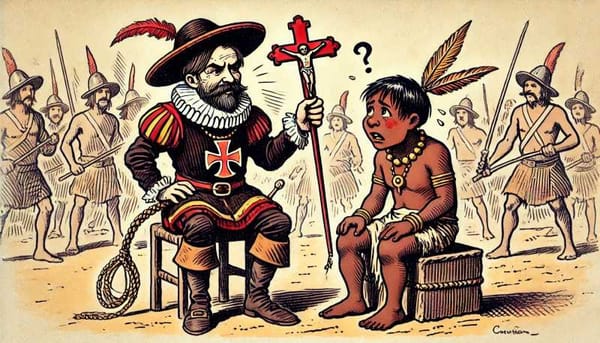Race in New Spain's caste paintings
Understand how caste was undoubtedly one of the methods of control in New-Hispanic society and represented an attempt to limit the power of the Creoles.

Caste was undoubtedly one of the methods of control in New-Hispanic society and represented an attempt to limit the power of the Creoles; however, it was exceeded by reality.
Four characters star in the painting, all with beautiful faces and poses that seek to reflect everyday life. As a whole, the elements in the painting convey a message of harmony and are presented as a beautiful picture of home life: a bearded man holds the reins of a donkey that carries a child on its back, who in turn holds a stick with which he seems to beat the pack animal; in front of them a woman wears a yellow dress and on her back, she carries a child in a tattered shawl that gives a glimpse of the infant's nakedness.
The painting is attributed to Miguel Cabrera, one of the most renowned New Spanish painters of the 18th century; among his most outstanding works are Portrait of Sister Juana Inés de la Cruz, The Martyrdom of Saint Sebastian, Virgin of the Apocalypse, and The Divine Shepherdess. However, in addition to his paintings with religious images and allegories, Miguel Cabrera is the author of an important series of paintings of castes, to which the described image belongs, which is called "De mestizo y de india; coyote".
The rise of the paintings of castes dates from the 18th century and their disappearance is projected approximately towards the 19th century with the processes of independence. The common denominator of these works is the presence of a couple (man and woman, each belonging to a supposedly different racial group) accompanied by their child with texts that allude to the designation they received within the caste system. Some of these paintings varied in content depending on the series to which they belonged and could represent trades, clothing, landscapes, flora, fauna, and objects that gave the works a realistic character; even, in some series the couples are portrayed amid a dispute and the infant is represented scared or crying.
Some painters of this genre are Manuel Arellano, Juan Rodríguez Juárez, Andrés de Islas, Ignacio Barreda, José de Páez, José Joaquín Magón, Francisco Antonio Vallejo, among others. The authors give particularities to each one of their paintings; however, all of them could coincide with the use of imaginary, scenes, or European forms to represent Indian or other caste characters. Such is the example of the work Diseño de india chichimeca, by Manuel Arellano, in which the figure of the indigenous woman does not differ from the representations of a European virgin, except for her skin color and elements that try to allude to America, such as the feathers in her headdress, the landscape and the bird perched on her arm.
Likewise, there is no coincidence in the numerous names of the mixtures represented. Some of the terms to designate the "products" of the mixtures are castizo, mestizo and mulatto; as well as others whose combinations are more complex: albino, chino, torna atrás, lobo, morisco, grifo, cambujo, albarazado, cuarterón, barcino, coyote, chamiso, gíbaro, zambaigo, calpamulato, tente en el aire, no te entiendo y ahí te estás. The origin of these terms comes mostly from those used to designate livestock.
The caste paintings are the result of the Spanish Bourbons' concern for order and race in a social reality that no longer fits into the black-and-white and European-Indian dichotomies. However, as the historian William Taylor points out, far from representing a celebration of multiculturalism and a precedent for the ideas of the nationalist exaltation of mestizaje, the caste paintings "placed people in their racial space by imposing an order on an unsanctioned mixture that had sprung up beyond legal limits".
For some authors, these paintings, beyond a catalog that reflected an existing reality, could represent efforts to make the caste system more functional or to build a discourse of power and control around the subjects who were involved in crossbreeding. Furthermore, the caste series shows in the mixtures a process of both racial and cultural whitening of the individuals involved.
"The colonial administration needed to make it clear that, despite its diversity, New-Hispanic society was perfectly regulated by a strict caste system. In particular, in a context in which, in the eyes of many Europeans, Spain represented a counterexample in the handling of mestizaje," notes Sofia Navarro in her text La pintura de castas más allá del afán clasificatorio: La serie de castas de Miguel Cabrera.
She adds: "What was at stake then was to show that, although mestizaje was a reality, New Spanish society had not degenerated: the products of the mixtures had a name (" lobo", "chino cambujo", "albarazado"), a perfectly-identified place in the social scale, as well as a trade that corresponded to them. Caste painting was thus an effective means of fixing the caste system in clear and convincing visual imagery.
Caste paintings were always commissioned and intended to be exhibited in other countries. Among those who requested such works were high-ranking officials of the viceroyalty and members of the upper ecclesiastical hierarchy of New Spain who was sympathetic to the Bourbon reforms, as noted by art conservator and historian Ilona Katzew.
Some authors point out that most of the castes portrayed were never practiced and that they were rather classifications that exotically projected the Indians and far from social reality, since as Taylor indicates, "some intermediate caste nominations must have satisfied more an imagined than a functional order", for New Spain society was complexly embedded in various systems of social stratification that was not reduced to what we now understand as a race but included economic class, kinship, residence, gender, and ethnicity.
There was a distance between what seemed to be the perfect classification and social reality, as explained by Patrick J. Carroll in his essay "The Academic Debate on the Meanings of Race and Class in 18th Century Mexico" through various cases that show the difficulty of putting this type of classification into practice and how these entered into opposition or tension with the differences in the process of indigenous identity construction. For example, the case of Francisco and María, who were married in the cathedral of San Pedro de Cholula in 1750 and, even though both, originally from San Jerónimo, said they were "Indians", the priest classified María as a "coyote" in the marriage registry.
Author: Ministry of Culture




